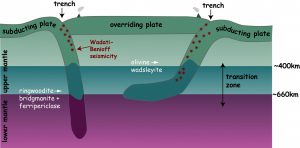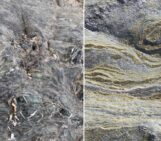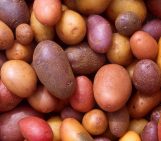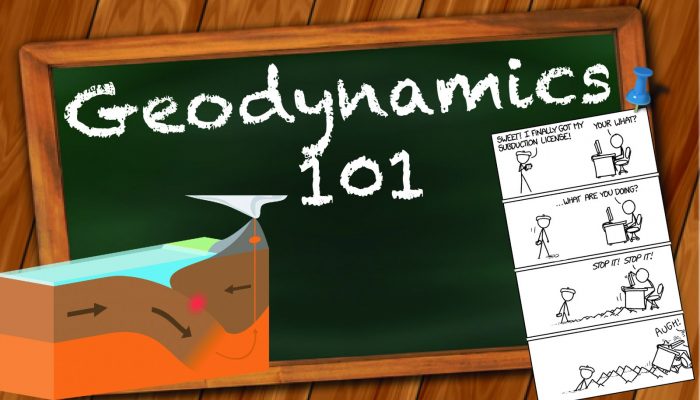
The Geodynamics 101 series serves to showcase the diversity of research topics and methods in the geodynamics community in an understandable manner. We welcome all researchers – PhD students to professors – to introduce their area of expertise in a lighthearted, entertaining manner and touch upon some of the outstanding questions and problems related to their fields. For our latest ‘Geodynamics 101’ post, Saskia Goes, Reader at Imperial College London, UK, discusses the fate of subducting slabs at the mantle transition zone.
Subducting plates can follow quite different paths in their life times. While some sink straight through the upper into the lower mantle, others appear to stall in the mantle transition zone above 660 km depth. Geodynamicists have long puzzled about what controls these different styles of behaviour, especially because there appear to be correlations between sinking or stalling with faster or slower plate motions and mountain building or ocean basin formation, respectively. In the long run, how easily slabs sink through the transition zone controls how efficiently material and heat are circulated in the mantle.
The word subduction derives from the Latin verb subducere, which means pulled away from below, but metaphorically can mean to lose footing or remove secretly. Definitely, when Wegener first proposed continental drift, people were unaware that subduction is removing plates from the Earth’s surface. We now know this process is not quite so secret. The plates creak in earthquakes as they sink into the mantle, in some cases all the way through the mantle transition zone to about 700 km depth. Furthermore, where the subducting plate bends below the overriding plate, it creates deep-sea trenches with prominent gravity and geoid signals. This bending is a very important part of subduction dynamics, as I’ll explain below.
The seismic Wadati-Benioff zones and gravity expressions were sufficient clues of the location of the downwelling limbs of a mantle convection system to help acceptance of plate tectonics in the 1960s. However, it took another twenty odd years until seismology yielded images of cold plates sinking into the mantle, and it turned out that the plates extend beyond the seismic Wadati-Benioff zones [Van der Hilst et al., 1991; Zhou and Clayton, 1990]. These images showed that some subducting plates flatten in the mantle transition zone (e.g. below Japan and Izu-Bonin), while others continue with little to no deflection into the lower mantle (e.g., below the Northern Kuriles and Marianas) (Fig. 1). Soon after, it was realised that many of the places where the slabs are flat in the transition zone have a history of trench retreat [Van der Hilst and Seno, 1993]. Furthermore, mapping of seafloor ages revealed that flat slabs tend to form where plates older than about 50 Myr are subducted [Karato et al., 2001; King et al., 2015].
Many mechanisms have been proposed for the variable slab transition-zone interaction. We recently reviewed the geodynamic and observational literature and combined these insights with those from our own set of mechanical and thermo-mechanical subduction models [Goes et al., 2017]. This effort shows that not one single mechanism, but an interplay of several mechanisms is the likely cause of the observed variable subduction behaviour.
It has long been realised that viscosity increases with depth into the mantle, quite possibly including jumps at the major phase transitions in the mantle transition zone. The ringwoodite-postspinel transition that is responsible for the global 660 km seismic discontinuity, usually taken as the base of the upper mantle, is an endothermic transition under most of the conditions prevailing in the mantle today. This means that the transition will take place at a higher pressure and thus depth in the subducting plate than the surrounding mantle, rendering the plate locally buoyant with respect to the mantle. Both these factors hamper the descent of the subducting plate through the transition zone. However, a viscosity increase within acceptable bounds (as derived from geoid and postglacial rebound modelling) can slow sinking, but does not lead to stalling material. By contrast, the phase transition can lead to stalling, as well as an alternation of periods of accumulation of material in the transition zone and periods where this material flushes rapidly into the lower mantle, at least in convection models without strong plates. But does this work with strong plates?
Making dynamic models of subduction with strong plates is challenging because the models need to capture strong strength gradients between the core of the plate and the underlying mantle, allow for some form of plate yielding, maintain a weak zone between the two plates and adequately represent the effect of plate bending (a free-surface effect). Most models prescribe at least part of the system by imposing velocities and/or plate geometries. This however needs to be done with great care and consideration for what forcing such imposed conditions imply.
“Pulled away from below” is a good description of the dynamics of subduction. Subduction is primarily driven by slab pull, the gravitational force on the dense subducting plate [Forsyth and Uyeda, 1975]. And to “lose footing” reminds us that gravity is the main driving force. Gravity tries to pull the plate straight down (Fig. 2), so the easiest way for a plate to subduct is to fall into the mantle, a process that leads to trench retreat [Garfunkel et al., 1986; Kincaid and Olson, 1987]. Besides letting the plate follow the path of gravity, subduction by trench retreat has the other advantage that the plate does not need to bend too much. Bending a high-strength plate takes significant energy. Some studies have shown that if plates are assigned laboratory-based rheologies, such bending can easily take up all of the gravitational potential energy of the subducting plate [Conrad and Hager, 1999], so if plates are to sink into the mantle, they have to do this by minimising the amount of energy used for bending into the trench. As a consequence, strong and dense plates prefer to subduct at smaller dip angles while weaker and lighter plates can be bent to subduct more vertically [Capitanio et al., 2007].
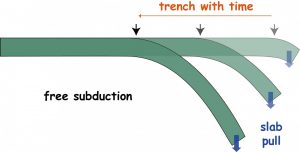
Figure 2: If subduction occurs freely, i.e., driven by the pull of gravity on the dense slab with sinking resisted by the viscous mantle, it is usually energetically most favourable to subduct by trench retreat.
The angle at which plates subduct strongly affects how they subsequently interact with viscosity or phase interfaces (Fig. 3). Steeply dipping plates will buckle and thicken when they encounter resistance to sinking. This deformation facilitates further sinking, as a bigger mass. But plates that reach the interface at a lower dip may be deflected. Such deflected plates have a harder time sinking onwards, both because the high viscosity resistance is now distributed over a wider section of the plate and due to the spread-out additional buoyancy from the depressed endothermic phase boundary.
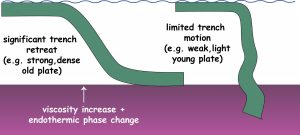
Figure 3: The subduction angle largely determines how the slab interacts with viscosity and phase changes.
So, variable plate density and strength can lead to variable behaviour of subduction in the transition zone. And we know plates have variable density and strength. Older plates are denser and if strength is thermally controlled, as most lab experiments predict, also stronger than younger plates. This implies that older plates can drive trench retreat more easily than young plates. And indeed this matches observations that significant trench retreat has only taken places where old plates subduct. Furthermore, significant trench retreat will facilitate plate flattening in the transition zone, consistent with the observation that flat plates tends to underlie regions with a history of trench retreat (even if that does not always mean trench motions are high at the present day). This mechanism can also explain why flat slabs tend to be associated with old plate subduction.
So what about the role of other proposed mechanisms? Our models with strong slabs show that only when slabs encounter both an increase in viscosity (which forces the slabs to deform or flatten) and an endothermic phase transition (which can lead to stalling of material in the transition zone) do we find the different modes of slab dynamics. Neither a viscosity increase alone, nor an endothermic phase transition alone leads to mixed slab dynamics.
Other factors likely contribute to the regional variability. In the cold cores of the slabs, some phases may persist metastably, thus delaying the transformations to higher density phases to a larger depth. Metastability will be more pervasive in colder old plates thus making older plates more buoyant and hence resistant to sinking than young ones. In combination with trench retreat facilitated by a strong slab at the trench, this can further encourage slab flattening [Agrusta et al., 2014; King et al., 2015]. Phase transformations may also lead to slab weakening in the transition zone because they can cause grain size reduction. Such weakening can aid slab deflection [Čížková et al., 2002; Karato et al., 2001]. However, several studies have shown that transition zone slab strength is less important than slab strength at the trench, which governs how a slab starts sinking through the transition zone.
The Earth is clearly more complex than the models discussed. For example, present-day plate dip angles display various trends with plate age at the trench. Lateral variations in plate strength and buoyancy can complicate subduction behaviour. Furthermore, forces on the upper plate and large-scale mantle flow may also impede or assist trench motions and may thus affect or trigger changes in how slabs interact with the transition zone [Agrusta et al., 2017]. All these factors remain to be fully investigated. However, the first order trends of subduction-transition zone interaction can be understood as a consequence of plates of various ages interacting with a viscosity increase and endothermic phase change.
References Agrusta, R., J. van Hunen, and S. Goes (2014), The effect of metastable pyroxene on the slab dynamics, Geophys. Res. Lett., 41, 8800-8808. Agrusta, R., S. Goes, and J. van Hunen (2017), Subducting-slab transition-zone interaction: stagnation, penetration and mode switches, Earth Planet. Sci. Let., 464, 10-23. Capitanio, F. A., G. Morra, and S. Goes (2007), Dynamic models of downgoing plate buoyancy driven subduction: subduction motions and energy dissipation, Earth Planet. Sci. Lett., 262, 284-297. Čížková, H., J. van Hunen, A. P. van der Berg, and N. J. Vlaar (2002), The influence of rheological weakening and yield stress on the interaction of slabs with the 670 km discontinuity, Earth Plan. Sci. Let., 199(3-4), 447-457. Conrad, C. P., and B. H. Hager (1999), Effects of plate bending and fault strength at subduction zones on plate dynamics, J. Geophys. Res., 104(B8), 17551-17571. Forsyth, D. W., and S. Uyeda (1975), On the relative importance of driving forces of plate motion. , Geophys. J. R. Astron. Soc. , 43, 163-200. Garfunkel, Z., C. A. Anderson, and G. Schubert (1986), Mantle circulation and the lateral migration of subducted slab, J. Geophys. Res., 91(B7), 7205-7223. Goes, S., R. Agrusta, J. van Hunen, and F. Garel (2017), Subduction-transition zone interaction: a review, Geosphere, 13(3. Subduction Top to Bottom 2), 1-21. Karato, S. I., M. R. Riedel, and D. A. Yuen (2001), Rheological structure and deformation of subducted slabs in the mantle transition zone: implications for mantle circulation and deep earthquakes, Phys. Earth Plan. Int., 127, 83-108. Kincaid, C., and P. Olson (1987), An experimental study of subduction and slab migration, J. Geophys. Res., 92(B13), 13,832-813,840. King, S. D., D. J. Frost, and D. C. Rubie (2015), Why cold slabs stagnate in the transition zone, Geology, 43, 231-234. Van der Hilst, R. D., and T. Seno (1993), Effects of relative plate motion on the deep structure and penetration depth of slabs below the Izu-Bonin and Mariana island arcs, Earth Plan. Sci. Let., 120, 395-407. Van der Hilst, R. D., E. R. Engdahl, W. Spakman, and G. Nolet (1991), Tomographic imaging of subducted lithosphere below northwest Pacific island arcs, Nature, 353, 37-43. Zhou, H.-w., and R. W. Clayton (1990), P and S Wave Travel Time Inversions for Subducting Slab Under the Island Arcs of the Northwest Pacific, J. Geophys. Res., 95(B5), 6829-6851.


